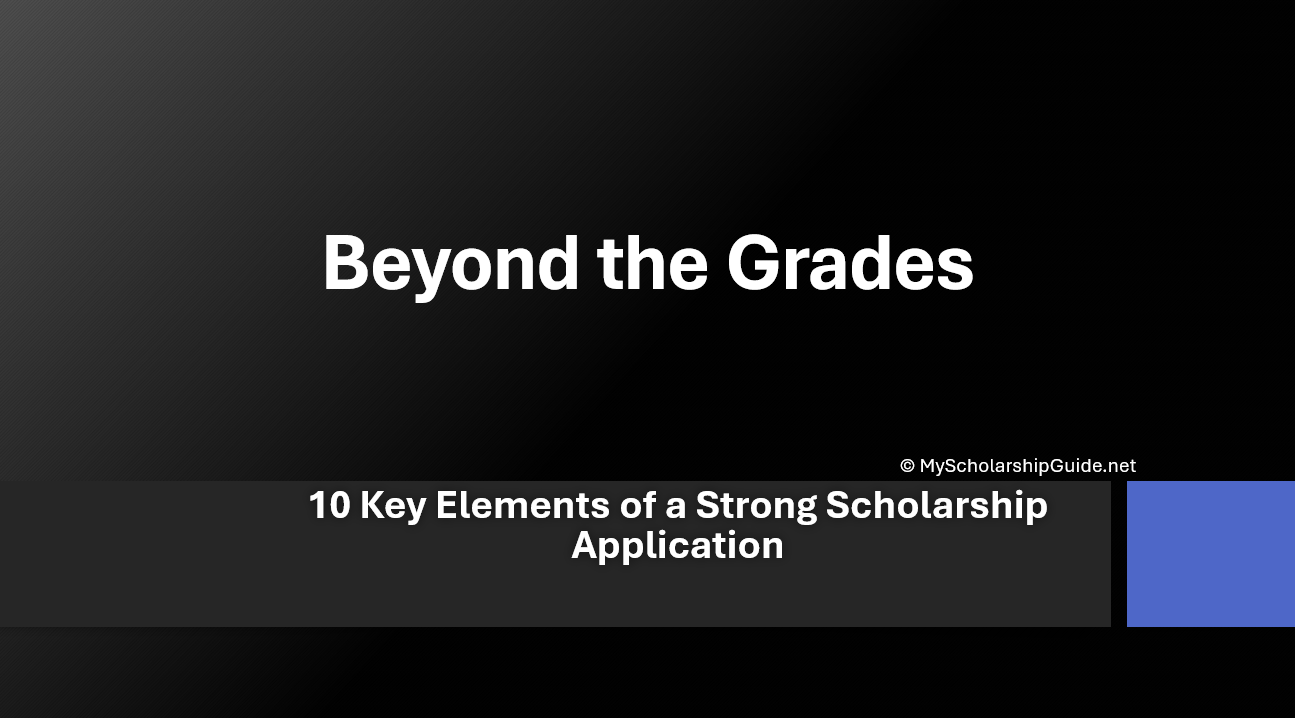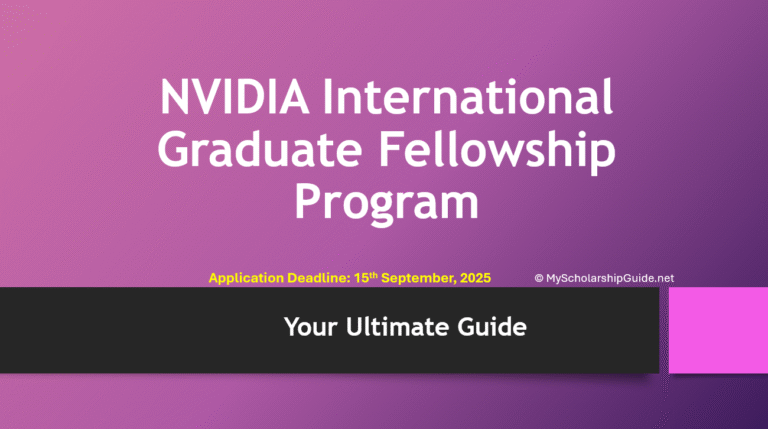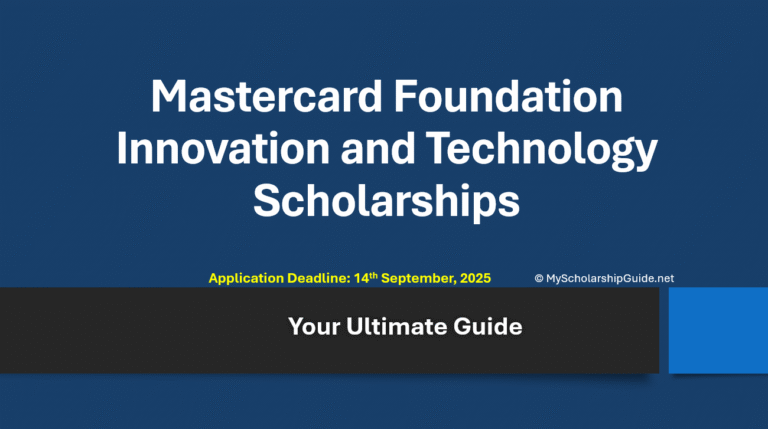Beyond the Grades: 10 Key Elements of a Strong Scholarship Application
Beyond the Grades: 10 Key Elements of a Strong Scholarship Application
The dream is powerful. It’s the vision of walking across a graduation stage in a foreign land, a diploma in hand, ready to build a better future for yourself and your family. But for many bright students across Africa, that dream often feels just out of reach, blocked by the towering wall of tuition fees. You’ve probably spent countless hours scouring the internet for opportunities, only to feel overwhelmed by the competition. You see stories of others getting scholarships and wonder, “What did they do differently?”
The truth is, securing a scholarship isn’t just about having perfect grades. It’s about a complete package—a story you tell through every single document you submit. A scholarship committee isn’t looking for just the smartest applicant; they’re looking for the best fit. They want to invest in a person who demonstrates potential, passion, and a clear vision. This comprehensive guide will break down the 10 key elements of a strong scholarship application, transforming your approach from hopeful to strategic. By the time you’re done reading, you’ll know exactly how to stand out from the crowd and present a compelling case for why you deserve that coveted spot.
1. The Power of Your Personal Statement (The Essay)
Your personal statement, or essay, is the heart and soul of your application. It’s your one chance to speak directly to the scholarship committee, to show them who you are beyond your academic transcripts. This is not a summary of your CV; it’s a narrative that connects your past experiences to your future aspirations.
Crafting a Compelling Narrative
Start with a powerful hook. Don’t just begin with, “I am writing to apply for the [Scholarship Name]…” Instead, open with an anecdote that illustrates a moment of personal growth, a challenge you overcame, or a passion that drives you. Think of it as a movie scene.
- Show, Don’t Just Tell: Instead of writing, “I am a determined person,” describe a time you persevered through a difficult project or a personal obstacle.
- Connect the Dots: Link your past experiences (volunteering, leadership roles, challenges) to the course you want to study and how it aligns with your long-term goals.
- Be Authentic: Your voice should be genuine. Don’t try to sound like someone you’re not. Let your unique personality and perspective shine through.
Answering the Prompt Carefully
Every scholarship essay prompt is a test. It’s a way for the committee to see if you can follow instructions and articulate your thoughts clearly. Read the prompt multiple times and highlight the key questions it asks. If it asks “Why this program?” and “How will you contribute to our community?”, make sure your essay addresses both questions directly and equally.
2. Strong Letters of Recommendation
A letter of recommendation is an external validation of your character and abilities. It’s a trusted voice vouching for you. The wrong letter can be a formality; the right one can be a game-changer.
Choosing the Right Recommenders
Don’t just pick the most senior person you know. Choose recommenders who know you well and can speak to your specific skills and experiences. Ideal recommenders include:
- A Professor or Lecturer: Someone who taught you a relevant course and can speak to your academic abilities, work ethic, and contributions in class.
- A Work Supervisor or Mentor: Someone who oversaw your work in an internship, a volunteer role, or a part-time job. They can attest to your professionalism, teamwork, and leadership potential.
Guiding Your Recommenders
Make it easy for them to write a strong letter. Don’t just send a request and wait. Provide them with:
- Your updated CV or resume.
- A copy of your personal statement draft.
- The scholarship’s name, deadline, and a brief description of why you are applying.
- A list of specific achievements or qualities you’d like them to highlight. This helps them write a detailed and tailored letter instead of a generic one.
3. The Flawless Academic Transcript
While not the only thing that matters, your academic transcript is the foundation of your application. It proves your ability to handle the rigours of higher education. A strong application requires a clean, official, and well-presented transcript.
Understanding GPA and Grading Systems
Different countries have different grading systems. A scholarship committee from a US university, for example, will need to understand what a “First Class” honours from a Nigerian university means. Be prepared to provide an official explanation of your university’s grading scale, usually included on the back of the transcript or in a separate document.
The Role of Official Transcripts
Most scholarships require an official transcript sent directly from your previous institution to the scholarship committee. Do not open the sealed envelope yourself. Follow the instructions precisely.
If you are a student from a country where university bureaucracy can be slow, start this process early! Delays in receiving your official transcript are a common reason for applications being disqualified.
4. A Polished and Professional CV or Resume
Your CV is a professional summary of your life’s work. It’s not a creative writing exercise; it’s a factual document that highlights your accomplishments and skills in a clear, concise, and easy-to-read format.
Key Elements of a Strong CV
- Contact Information: Ensure all details (phone number with country code, professional email address) are correct and up-to-date.
- Education: List your degrees in reverse chronological order. Include the institution, location, dates attended, and your major.
- Work Experience: Use action verbs to describe your roles and responsibilities. Quantify your achievements whenever possible (e.g., “Increased sales by 15%,” “Managed a team of 5”).
- Volunteer Experience & Leadership Roles: This section is crucial. It demonstrates your commitment to your community and your ability to take initiative.
- Skills: Include both hard skills (e.g., Python, AutoCAD, proficiency in specific software) and soft skills (e.g., teamwork, communication, problem-solving).
Tailoring Your CV
Just like your personal statement, your CV should be tailored for each scholarship. Highlight experiences and skills that are most relevant to the program or the values of the scholarship provider. If a scholarship is focused on social impact, emphasize your volunteering and community-based projects.
5. Evidence of Leadership and Extracurricular Activities
Scholarship providers are looking for future leaders who will make a difference in the world. Your leadership skills and extracurricular activities are proof that you are more than just a student with good grades. They show your character, your initiative, and your ability to work with others.
Demonstrating Leadership
Leadership isn’t just about holding a title like “President” or “Team Lead.” It’s about influence and impact.
- Did you mentor a junior student?
- Did you organize a community project or a study group?
- Did you take the lead on a challenging group project?
Describe the context, your role, and the positive outcome of your actions.
The Importance of Extracurriculars
Your hobbies, sports, or club memberships can reveal a lot about your personality and time management skills. Being a member of a debate club shows strong communication skills; playing a team sport demonstrates collaboration and discipline. These activities show you are a well-rounded individual with passions outside of academia.
6. Standardized Test Scores (e.g., GRE, GMAT, TOEFL, IELTS)
For many international scholarships, especially in the US and Europe, standardized test scores are a non-negotiable part of the application. These tests provide a common benchmark for evaluating applicants from diverse educational backgrounds.
Which Tests Are Required?
- Language Proficiency Tests: The TOEFL (Test of English as a Foreign Language) and IELTS (International English Language Testing System) are the most common.
- Graduate School Tests: The GRE (Graduate Record Examinations) is a common requirement for many master’s and Ph.D. programs. The GMAT (Graduate Management Admission Test) is typically required for business and management programs.
Planning and Preparation
Studying for these tests takes time and discipline. Start preparing months in advance. Utilize free resources online, practice tests, and study groups. A strong score can significantly boost your application, especially if your GPA is not the highest. A weaker score, on the other hand, can be a red flag.
7. The Statement of Purpose (SOP)
While often used interchangeably with the personal statement, the Statement of Purpose (SOP) has a distinct focus. The SOP is a more academic and career-oriented document. While the personal statement answers “Who are you?”, the SOP answers “Why this program, and why me?”
Key Components of a Strong SOP
- Academic History: Briefly summarize your academic and research background. Highlight specific coursework or projects that prepared you for this program.
- Research Interests: Clearly state your research interests and explain why they align with the work of a specific professor or the program’s focus. This is where you show you’ve done your homework.
- Future Goals: Articulate your short-term and long-term career goals. Explain how this specific program will help you achieve them.
- Why This University?: Be specific. Mention unique courses, research labs, or professors that drew you to this institution. This shows you are not just applying everywhere but have a genuine interest in their program.
8. Financial Need and Motivation
While many scholarships are merit-based, others consider financial need. Even for merit-based scholarships, demonstrating a clear motivation and understanding of the financial opportunity can strengthen your application.
The Financial Need Statement
If required, be honest and specific. Outline your financial situation and how the scholarship will make a tangible difference in your ability to pursue your education. Avoid emotional pleas and focus on facts. Explain how you and your family plan to cover the remaining costs.
The “Why You?” Factor
In your essay or interview, be prepared to talk about how this scholarship will transform your life and the lives of those around you. The most successful applicants often tie their personal ambitions to a larger purpose, whether it’s solving a problem in their community or contributing to a field of study.
9. A Comprehensive and Well-Organized Portfolio
For fields like architecture, design, art, or creative writing, a portfolio is a critical component. It is a visual representation of your skills and potential.
Creating a Standout Portfolio
- Quality over Quantity: Curate your best work. Don’t include everything you’ve ever created. Show your growth and range.
- Clarity and Context: For each piece, include a brief description of the project, your role in it, the materials used, and the concept behind it.
- Digital Format: Most scholarships will require a digital portfolio. Follow their formatting guidelines precisely (e.g., PDF size limits, image resolution).
- Tell a Story: Your portfolio, like your essay, should tell a story about your creative journey and your unique style.
10. The Interview (If Applicable)
Congratulations! If you’ve been invited for an interview, you’ve already passed the initial screening. The interview is your chance to expand on your application and make a lasting personal impression.
Preparing for the Interview
- Know Your Application Inside and Out: Be ready to talk about anything on your CV, personal statement, or SOP. Don’t let a detail surprise you.
- Anticipate Common Questions: Practice answering questions like: “Why do you want this scholarship?”, “What are your greatest strengths and weaknesses?”, “Tell me about a time you failed and what you learned.”
- Do Your Homework: Research the scholarship provider, the university, and the program. Be prepared to ask insightful questions that show your genuine interest.
- Practice Your Delivery: Record yourself answering questions. Pay attention to your tone of voice, body language, and clarity. Be confident, but not arrogant.
Frequently Asked Questions (FAQs)
How important is my GPA compared to my extracurriculars?
A strong GPA is the foundation, but extracurriculars are the pillars. Your GPA proves you have the academic ability to succeed. Your extracurriculars, leadership roles, and volunteer work prove you have the character, drive, and passion to make an impact. Most scholarship committees look for a balance. A perfect GPA with no other activities can be less compelling than a slightly lower GPA from a student who is actively involved in their community and demonstrates leadership potential.
Should I pay a scholarship application fee?
Most reputable scholarships do not charge an application fee. Be extremely cautious of any “scholarship” that requires a payment upfront. Always verify the organization’s legitimacy. Check their official website and look for reviews.
Can I apply for a scholarship before I have my final grades or test scores?
Many scholarships allow you to apply with a provisional transcript or pending test scores, as long as you provide a plan to submit the final documents as soon as they become available. However, some have strict deadlines for all materials. It is crucial to check the specific requirements for each scholarship. Don’t assume.
What if I don’t have a lot of leadership experience?
Leadership isn’t just about holding a formal title. Think about times you took initiative. Did you lead a study group, organize a small event for a student club, or help a friend with a difficult project? Reframe your experiences to highlight where you took ownership and demonstrated responsibility. Every small act of initiative counts.
Is it okay to apply for multiple scholarships at once?
Absolutely. In fact, it is highly recommended. The scholarship application process is competitive, and applying to just one or two is like putting all your eggs in one basket. Create a spreadsheet to track application deadlines, requirements, and the status of each application to stay organized and efficient.
10 key elements of a strong scholarship application – Your Next Steps to Success
You now have a powerful roadmap. You know that a successful application is a holistic package—a narrative built on a solid foundation of academic excellence, personal passion, and a clear vision for the future. The grade on your transcript is just one piece of the puzzle. The true strength of your application lies in the story you tell and the person you present to the committee.
Your immediate next step is to take action. Open a new document and start brainstorming the stories you want to tell in your personal statement. Look at your CV and identify areas where you can add more impactful details. Reach out to potential recommenders today. The journey to a scholarship is a marathon, not a sprint. Start strong, stay organized, and remember why you are doing this. You have what it takes. Now go and show them.
Disclaimer
Unless otherwise stated, www.myscholarshipguide.com is not affiliated with any of the scholarship providers listed on our website, nor do we process applications on behalf of any organization. The content provided is for informational purposes only, and visitors are encouraged to use this information at their own discretion.







